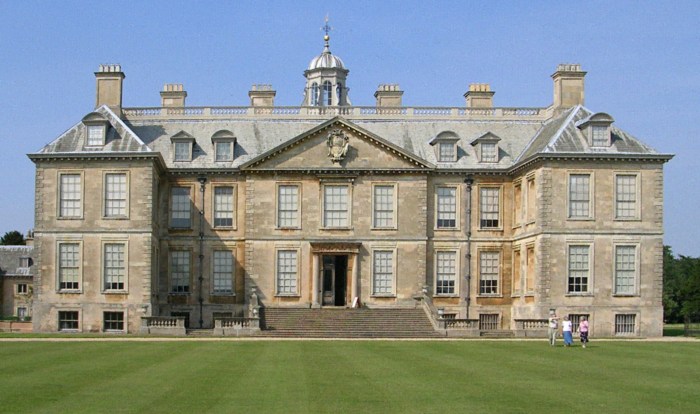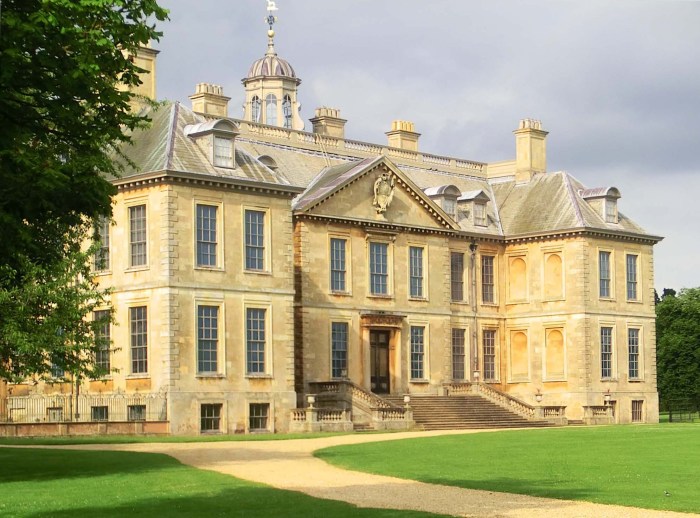Belton House, a magnificent stately home nestled in the heart of Lincolnshire, England, invites you on a captivating journey through time and architectural artistry. Its rich history, stunning design, and sprawling gardens have made it a beloved destination for centuries.
Built in the 17th century, Belton House has witnessed the passage of time, from its humble beginnings as a medieval manor to its transformation into a grand Baroque masterpiece. Its architectural evolution reflects the changing tastes and aspirations of its successive owners, showcasing a harmonious blend of grandeur and elegance.
Historical Significance

Belton House, a magnificent Grade I listed building, holds a prominent place in British history. Built between 1685 and 1688, the house was commissioned by Sir John Brownlow, a wealthy landowner and politician, and designed by the renowned architect William Winde.
Architectural Styles, Belton house
Belton House showcases a harmonious blend of architectural styles. The exterior boasts a striking Baroque facade, characterized by its grand portico, ornate carvings, and sweeping curves. The interior, however, exhibits a more restrained Classical style, featuring elegant plasterwork, marble fireplaces, and intricate wood paneling.
Significance in British History
Belton House played a significant role in British politics and society. It was visited by royalty, including King William III and Queen Mary II, and hosted important political gatherings. The house’s grand reception rooms and lavish furnishings reflected the wealth and influence of the Brownlow family.
Owners and Occupants
- Sir John Brownlow (1644-1719): Original owner and builder of Belton House.
- Brownlow Bertie, 1st Duke of Ancaster and Kesteven (1692-1779): Inherited Belton House through marriage and expanded the estate.
- Sir Richard Cust, 1st Baronet (1710-1799): Purchased Belton House in 1761 and made significant alterations to the interior.
- National Trust (acquired in 1984): Preserves and manages Belton House as a historical property open to the public.
Architectural Features
Belton House is renowned for its impressive architectural features, both externally and internally. Its grand facade, intricate interior design, and unique architectural elements make it a captivating example of 17th-century Baroque architecture.
Belton House, an 18th-century stately home in Lincolnshire, England, is known for its stunning architecture and landscaped gardens. Its opulent interiors and grand halls have been used as filming locations for various period dramas. For those interested in exploring other historic landmarks in the UK, the picturesque town of Beaumaris on the Isle of Anglesey is worth considering.
Beaumaris boasts a magnificent castle and charming medieval streets, offering a glimpse into the rich history of Wales. Upon returning to Belton House, visitors can continue to marvel at its impressive collection of paintings, furniture, and artifacts.
Exterior Architecture
The exterior of Belton House is characterized by its symmetrical facade, adorned with intricate stone carvings and decorative details. The grand entrance is flanked by two imposing towers, each featuring a clock and a bell.
The facade is further enhanced by large windows with stone surrounds and mullions. The windows on the ground floor are particularly striking, with their arched tops and elaborate pediments.
Belton House is a beautiful stately home with over 1,000 acres of stunning parkland, including an arboretum that houses a wide variety of trees and shrubs. If you’re interested in exploring more arboreta, I highly recommend visiting the arboretum dallas , which is home to over 66 acres of gardens and 11 different plant collections.
After your visit to the arboretum, be sure to return to Belton House to explore the rest of its beautiful grounds.
The main entrance to the house is through a grand double staircase, which leads to a central courtyard. The courtyard is surrounded by a colonnade of arches, supported by Doric columns.
Interior Design
The interior of Belton House is equally impressive, with its grand staircase, state rooms, and bedrooms.
Belton House, with its grand halls and stunning gardens, is a true architectural marvel. But did you know that just a short drive away lies another natural wonder, the angel oak tree ? This ancient live oak is estimated to be over 400 years old and is a breathtaking sight to behold.
Its massive canopy and sprawling branches create a cathedral-like atmosphere, making it a must-see for any visitor to the area. And after marveling at the angel oak tree, be sure to return to Belton House for a glimpse into the past.
The grand staircase is one of the most notable features of the house. It is a sweeping, double staircase with carved stone balusters and a vaulted ceiling. The staircase leads to the first floor, where the state rooms are located.
The state rooms include the Great Hall, the Drawing Room, and the Dining Room. These rooms are all grandly decorated, with high ceilings, elaborate plasterwork, and fine furnishings.
The bedrooms at Belton House are also noteworthy. They are spacious and well-appointed, with four-poster beds and other fine furnishings.
Unique Architectural Elements
Belton House is distinguished by several unique architectural elements, including:
- The Long Gallery: This is a long, narrow room on the second floor, which was originally used as a library.
- The Chapel: The chapel is a small, private chapel located on the ground floor.
- The Orangery: The orangery is a large, greenhouse-like structure, which was used to grow exotic plants.
These unique elements add to the architectural interest and charm of Belton House.
Gardens and Grounds
Belton House is surrounded by breathtaking gardens and grounds that span over 1,300 acres, creating a landscape of horticultural wonders. The gardens have evolved over centuries, showcasing a harmonious blend of formal and informal styles, each with its own unique charm and historical significance.
Formal Gardens
The formal gardens, meticulously designed in the 17th century, exude elegance and symmetry. They feature manicured lawns, ornate fountains, and elaborate parterres filled with vibrant blooms. The Great South Front, with its sweeping views of the gardens, is a testament to the grandeur of this era.
Woodland Walks
Beyond the formal gardens, Belton House offers tranquil woodland walks that meander through ancient trees and lush undergrowth. The Temple Wood, with its serene lake and classical temple, provides a picturesque retreat. The Serpentine Walk, lined with majestic oaks, leads to a picturesque bridge over the River Witham.
Lakes
Belton House is renowned for its picturesque lakes, which add an element of tranquility to the landscape. The Long Water, a long, narrow lake, stretches along the eastern side of the house, reflecting the elegant architecture in its shimmering waters. The Round Pond, a circular lake located near the formal gardens, offers a peaceful spot for contemplation.
The gardens and grounds of Belton House have undergone significant transformations over the centuries, reflecting the changing tastes and lifestyles of its owners. In the 18th century, Capability Brown redesigned the landscape, creating a more naturalistic and picturesque style. The gardens were further enhanced in the 19th century with the addition of exotic plants and the construction of new structures, such as the Conservatory.
Today, the gardens and grounds of Belton House are a testament to the horticultural artistry and historical legacy of the estate. They offer a captivating experience for visitors, showcasing the beauty of nature and the grandeur of human design.
Collections and Exhibitions

Belton House is renowned for its impressive collections that reflect the grandeur and history of the Grantham family. The curatorial approach showcases the continuity and evolution of the family’s taste and lifestyle over several centuries.
The house displays a significant collection of artworks, including paintings by renowned artists such as Sir Joshua Reynolds, Thomas Gainsborough, and George Stubbs. These masterpieces depict family members, historical events, and landscapes, offering insights into the family’s social and cultural connections.
Belton House also boasts an extensive collection of furniture, spanning various periods and styles. Visitors can admire pieces from the Elizabethan era to the Regency period, showcasing the changing tastes and craftsmanship throughout history. The collection includes intricate carvings, elegant upholstery, and rare pieces that demonstrate the family’s wealth and status.
Furthermore, the house displays a range of artifacts that tell the story of the family and the estate. These include personal belongings, documents, and objects that provide glimpses into the lives of the Grantham family. The curatorial approach aims to connect the collections to the history of the house and its inhabitants, creating a rich and engaging experience for visitors.
Visitor Information

Planning a visit to Belton House is easy with our comprehensive guide. Discover admission prices, opening hours, guided tour options, and amenities to enhance your experience.
Admission Prices
- Adults: £15.00
- Children (5-16 years): £7.50
- Family (2 adults + 2 children): £36.00
- Groups (10+): £12.00 per person
Opening Hours
- April – October: Daily, 10:00 AM – 5:00 PM
- November – March: Tuesday – Sunday, 11:00 AM – 4:00 PM
Guided Tours
Enhance your visit with a guided tour led by our knowledgeable team.
- House Tour: £5.00 per person (in addition to admission)
- Garden Tour: £3.00 per person (in addition to admission)
- Combined House and Garden Tour: £7.00 per person (in addition to admission)
Amenities
- Cafe: Serving a range of refreshments and light meals
- Gift Shop: Offering a selection of souvenirs and Belton House merchandise
- Parking: Ample free parking available on-site
- Accessibility: Belton House is wheelchair accessible with designated parking and ramps
Getting Here
Belton House is conveniently located in Grantham, Lincolnshire.
- By Car: Take the A1 and exit at Grantham. Follow signs for Belton House.
- By Train: The nearest train station is Grantham, with regular services from major cities.
- By Bus: There are regular bus services from Grantham to Belton village.
Nearby Attractions
Extend your visit with a trip to these nearby attractions:
- Grantham Museum: Explore the history and culture of Grantham
- Belvoir Castle: Visit the magnificent stately home and gardens
- Woolsthorpe Manor: Discover the birthplace of Sir Isaac Newton
Concluding Remarks

Belton House stands as a testament to the enduring power of architecture and the enduring legacy of its former inhabitants. Its captivating story, stunning beauty, and exceptional collections continue to inspire and enchant visitors to this day, making it a must-visit destination for anyone seeking a glimpse into England’s rich heritage.
Key Questions Answered: Belton House
What is the best time to visit Belton House?
The best time to visit Belton House is during the summer months, when the gardens are in full bloom and the weather is most pleasant.
Are there any special events held at Belton House?
Yes, Belton House hosts a variety of special events throughout the year, including concerts, exhibitions, and seasonal festivals.
Is Belton House suitable for children?
Yes, Belton House is a great place for children to visit. There are plenty of things to keep them entertained, including a playground, a maze, and a discovery trail.